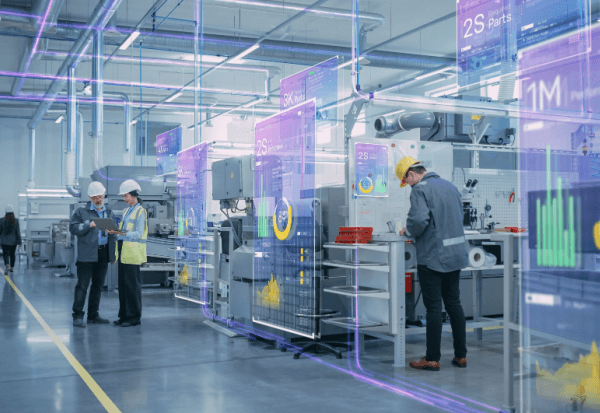Scaling Business thru’ Digital Capital
In today’s world, when digital has become the center of all innovation, cost of creating multiple solutions can override the benefits. In such scenario creating an environment to ensure the ideation, execution and implementation of digital solutions is cost effective, scalable and with high reusability is the key to maximizing the ROI on the digital innovation and initiatives. That’s where “Digital Factory” comes into picture. A well-functioning Digital Factory means a well collaborating, highly functional development team delivering software products that positively impact the business in a timely fashion with quality and thereby helping the entire enterprise achieve the strategic goals. The key benefits that any enterprise would like to reap with a well-functioning Digital Factory would be.
- Digital Business Delivery
- Enhanced Collaboration, Co-creation and Reuse within/between Teams
- Streamlined Software Product Development Lifecycle across the enterprise
- Constant Improvement of Software Product Delivery Quality & Agility
- Improved Time to Value.
Why Digital Factory?
Typically, any enterprise is marred with the following problem statements and pain points:
- Following Archaic Delivery Models
- Longer Development and Testing Cycles
- Disparate technology choices across the enterprise
- Limited reuse of technology and Processes
- Less or No Interoperability in legacy systems
- Suffering Business Value Chain
Digital Factory helps in enabling delivery of predictable & consistent quality software products with agility across the enterprise through improved collaboration, consistent secure software product development processes, centralized technology focus, reuse, automation, and analytics driving better business value.
How Digital Factory?
Digital Factories are inspired by Industrial Factory operations applied in software product development context. The Digital Factory attempts to replicate the assembly line in a physical factory to churn out software products. However, no two software are similar to a product produced in a factory. The concept is to establish repeatable processes which can be easily understood to build software products as components that can also be reused for future software product development through continuous engagement of the team. Once the process, skill and technology are established, the project/product teams shall execute the delivery of projects/products with agility and quality.
Digital Factory requires intellectual investments along with monetary, such as harvesting best practices and patterns from the existing projects, products, platforms, and programs and forming them into reusable assets (e.g., templates, class libraries, artifacts, APIs, design assets etc.) that need to be recouped by savings achieved with each software product built with a factory.
- People are the core of the Digital Factory and instrumental in giving life to the whole concept of Digital Factory. Far too often, business transformation efforts focus solely on the process improvement strategies and business process re-engineering, while essentially ignoring the people aspect of the change initiative.
- Processes are the skeleton of the Digital Factory that brings in a definite structure to the whole of software development and ensure all teams follow the defined processes, established estimation techniques, collects regular feedbacks, acts on those feedbacks to showcase value, gets audited regularly for the compliances of processes agreed, measures themselves and gets reviewed through meaningful metrics & KPIs. This will drive uniformity that helps in creating digital capital that is repeatable and predictable.
- Technology is like the machinery in a manufacturing factory. Technologies may evolve or new versions may come, or older technologies will get replaced by new ones. However, Digital Factory needs to identify tools and technology that may stand the test of a defined time and get invested in it. Having said that there should be established processes to review, add, modify, and remove tools and technologies based on the perceived value of change driven by market trends and business needs.
Digital Factory is there to help and ease software development through possible automation of process & technology to bring in people efficiency. It is purely based on promoting the reusability of architectures, knowledge, and components. Effective implementation of Digital Factory helps to move ideas and requirements to high quality software products at the speed of relevance while reducing costs. A Digital Factory Setup involves
- Streamlining Software Product Development Processes and Collaboration to achieve improved Visibility.
- Implementing Uniform Delivery Model across the enterprise to drive Consistency.
- Overcoming Knowledge Silos, promote reuse to avoid Redundancy and improve Efficiency.
- Driving Informed Decision powered by Metrics, KPIs & Insights to enhance Predictability.
- Automating everything possible to improve Agility.
- Driving continuous improvement to deliver better Quality.
Digital Factory – Digitally Agile.
Digital Factory is a step towards being able to deliver predictable quality, consistently with efficiency and agility. It is a transformation program, technically it is a platform of an integrated set of tooling, services, data, and processes that help teams to plan, build, test, release, and/or operate and manage the software. However, success is when there is adoption of this transformation by the people. Digital Factory is all about well-functioning teams who work hard on shared goals across the enterprise employing optimized technologies, leveraging validated digital capital components of reuse, applying improved quality, engineering & operational processes (automating everything possible) and applying insights to take actions.

is a Vice President & Head of Digital Technologies for Digital Business Solutions at Happiest Minds.
He has 22 plus years of experience in the Technology Industry. He provides leadership around Cloud Computing, Microservices, Enterprise Integration & Process Automation, DevSecOps, Cognitive QA, Blockchain among other innovations. He is responsible for defining the technology strategy for enterprise solutions, products and platform engineering across technology practices within Digital Business Solutions. His expertise and interest lies in rolling out Digital Adoption initiatives leveraging niche technology platforms, driving large scale Digital Transformation to achieve Business Innovation powered by Customer Delight and Intelligent Business Operations. As a digital evangelist and thought leader, Ramu provides strategic leadership mentoring along with advising clients and articulating business scenarios with insightful knowledge of technology deployment and in defining strategic objectives of transformation.




